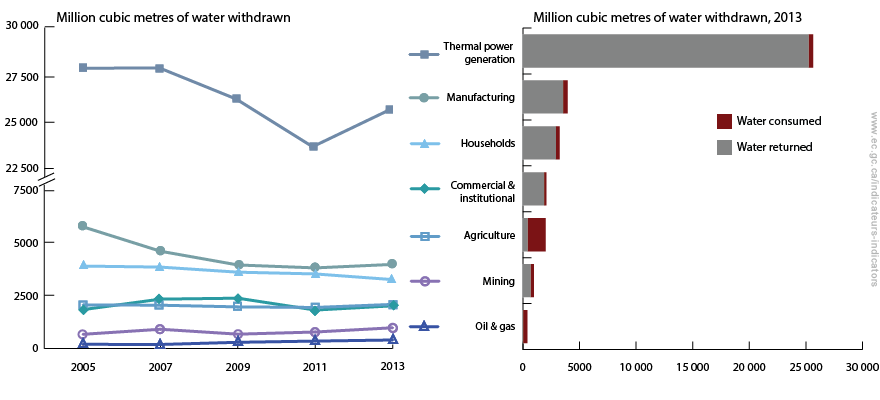Industry Uses
Industry Uses
Industry users are among the top water users in Canada. This includes thermal power generation, manufacturing, oil & gas production and mining. There are two basic ways in which we use water: Instream uses, which includes hydroelectric power generation, transportation, fisheries, wildlife, recreation, and waste disposal, take place with the water remaining in its natural setting. A good way to remember this is natural setting “in the stream”. Withdrawal uses, which includes thermal power generation, mineral extraction, irrigation, manufacturing, and municipal use, remove water from its natural setting for a period of time and for a particular use, and eventually return all or part of it to the source. The difference between the amount of water withdrawn and the amount of water returned to the source is water “consumed.” For example, by evaporating and not returning to the local source.
Environment Canada created the following graph to illustartes the net water use of the main water users in Canada from 2005 to 2013.
In 2013 the total water withdrawal across the main industries was almost 40 million cubic metres. Thermal power generation uses the highest amount (65%), manufacturing (10.5%), households (8.5%), commercial and instituional (5.5%), agriculture (5%), mining (2.5%) and oil & gas (1.5%). .
Tool Helps Global Companies Manage Water
Do you have staff, equipment, offices, datacenters in various water-scarce areas? As companies get decentralized across the globe, water management can become a concern. The World Business Council for Sustainable Development has launched the Global Water Tool. It’s a free and easy-to-use tool for companies and organizations to map their water use and assess risks relative to their global operations and supply chains.
City and Regional Water Management Tools
WaterSimTool is a simulation of water supply and demand for the Phoenix Metropolitan area that integrates information about climate, land use, population growth, and water policy. Adjustable settings allow you to gauge future water-supply conditions in response to climate change, drought, population growth, technological innovation, as well as policy decisions about the nature of the region’s built environment, landscaping practices, and recycled water. Other modelling and simulation tools are found here.

